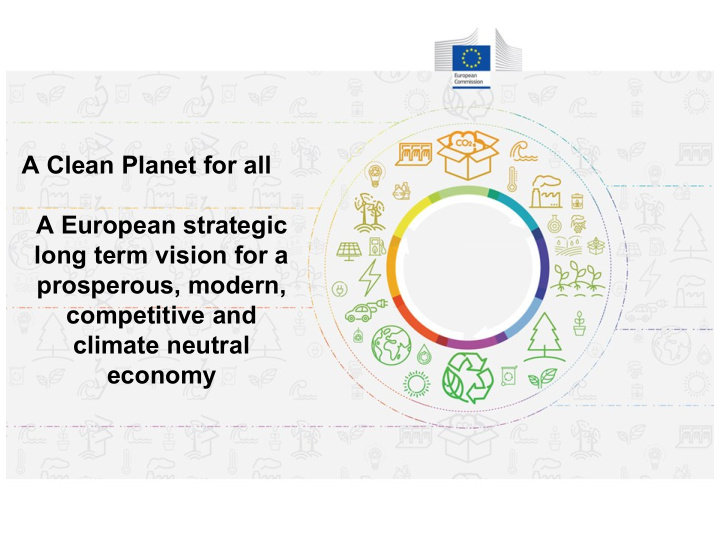



A Clean Planet for all A European strategic long term vision for a prosperous, modern, competitive and climate neutral economy
Building blocks for 2050 1.Energy efficiency 2.Deployments of renewables 3.Clean, safe & connected mobility 4.Competitive industry and circular economy 5.Infrastructure and inter-connections 6.Bio-economy and natural carbon sinks 7.Tackle remaining emissions with carbon capture and storage
Vision for a Clean Planet by 2050 Several pathways for a climate neutral Europe, challenging but feasible from technological, economic, environmental and social perspectives Non-CO2 other Different zero GHG pathways Non-CO2 Agriculture lead to different levels of remaining emissions and Residential absorption of GHG emissions Tertiary Transport Industry Power Carbon Removal Technologies MtCO2eq MtCO2eq LULUCF Net emissions
Innovation Fund Carbon Capture Renewable Use and energy Storage Driving low-carbon technologies to the market Energy- intensive Energy storage industries including substitute products
Key features of the Innovation Fund Support of up to Volume of at least First call expected 60% of additional EUR 10 billion at for 2020 and costs related to current carbon regular calls up to innovative prices 2030 technology Support of Comprehensive Financed from the additional capital selection criteria revenues of the EU and operating and project Emissions Trading costs (up to 10 development System years) assistance
Innovation Fund complementarities First-of-a- Research Infrastructure kind Connecting Horizon Europe Facility Europe Innovation Modernisation Fund Fund Partnerships Cohesion Funding InvestEU Member State Funding
Technology and business Greenhouse gas emissions avoidance Selection criteria Degree of innovation Project maturity Scalability Cost efficiency
Two-stage selection process Expression of interest Criteria (a) and (b) are met Award of Award of (a) GHG emissions avoidance project project (b) Degree of innovation development development List of assistance assistance (c) Project maturity pre- selected Criteria (a), (b), (c) projects are met to be Full application consulted with MS (a) GHG emissions avoidance Award of Award of (b) Degree of innovation project project (c) Project maturity grants grants (d) Scalability (e) Cost efficiency
Support across project life-cycle Financial Financial Entry into Entry into Grant Grant Award Award Close Close Operation Operation 3 to 10 years Add'l project Add'l project Annual Annual milestones milestones instalments instalments Feasibility Reporting FEED Construction Study period Payments 40% 60% At least 60%, dependent on verified Up to 40%, non-dependent emissions reductions on verified emissions reductions
Timeline – Innovation Fund Adoption Delegated First call for Regulation proposals 26 February 2019 mid-2020 Preparations for first call Industry workshops Public consultation on conditions for first call
How to match project design and Innovation Fund (IF) support Complexity and Complexity and Additional costs Additional costs Timing Timing synergies synergies and risks and risks # of activities What are the and partners major costs and Can project be e.g. CCUS or risks? split in several sector coupling stages? IF support for Target IF capital and/or support to operating costs? certain (construction vs activities? operation) IF support to be Synergies with To which extent provided over should risks (e.g. other funding several calls? carbon price) be e.g. for covered? infrastructure
How to best select projects? What are "best practice" examples? • e.g. ARPA-E programme by US DoE • Other EU programmes Selection criteria • How to calculate emissions avoidance? • How to assess degree of innovation and market potential? • Which level of proof for technical, regulatory and financial feasibility and readiness? • Cost efficiency based on NER300 experience Selection process • Which level of proof for expression of interest? • Which level of proof for full assessment?
https://ec.europa.eu/clima/policies/innovation-fund_en #InnovationFund
Recommend
More recommend